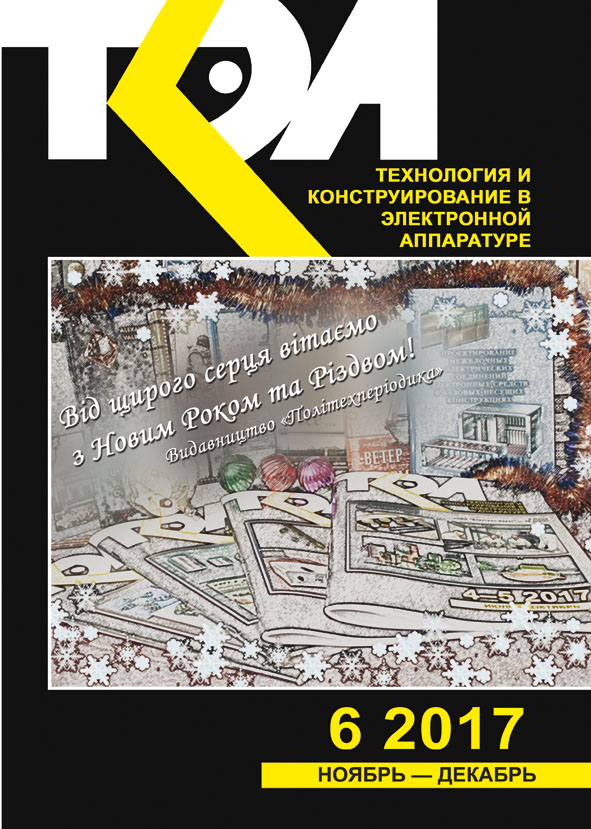Correlation scheme of frame synchronization in communication systems with QPSK-modulation
Abstract
The information efficiency of communication systems using quadrature amplitude modulation is reduced because of the costs for data transmission necessary to provide frame synchronization and the required time to search for the sync signal and to go into the tracking mode of the synchronization system.
One of the most effective schemes of constructing a frame synchronization system is the correlation diagram. In order for this diagram to operate, signal-code constructions with good aperiodic autocorrelation properties are required.
The aim of this study is to develop an effective frame synchronization system for quadrature modulation communication systems based on binary signal-code sequences with an ideal sectioned non-periodic autocorrelation function.
In this paper, we propose a frame synchronization scheme for QPSK modulation based on binary sequences of even length with an ideal autocorrelation function. All binary synchronous sequences of length N = 8 with the idealness of the autocorrelation function are analytically found in the study. On the basis of the chart of the code distance spectrum in the Hamming metric for binary sequences of N = 8 length, it was established that such sequences have a correcting ability that allows correcting single errors. Based on the structural properties of binary sequences of N = 8 length, sequences of a larger multiple length (N = 16, N = 32, etc.) can be synthesized.
The practical value of the proposed scheme of frame synchronization is to reduce the complexity of technical implementation and increase the overall noise immunity of the communication system. The proposed approach can be successfully used to synchronize communication systems with QAM modulation with a large number of signal positions such as QAM 16, QAM 64, etc.
References
Mazurkov M.I., Sadchenko A.V. [Properties of discrete APM-signals, invariant to the m-shift]. Trudy UNIIRT, 1996, no 2, P. 38-45. (Rus)
Mazurkov M.I., Sadchenko A.V., Skopa A. A. [Methods of information transfer on the basis of cyclic APM- and DFМ-signals, invariant to the m-shift]. Informatika i svyaz. Sb. Nauchnykh trudov UGAS. Kiev: Tekhnika, 1996, no 1, pp. 127-132. (Rus)
Sadchenko A. V., Averochkin V. А., Kushnirenko O. A., Petrusenko N. A. [Algorithm for the synthesis of binary sync codes of arbitrary length with good aperiodic autocorrelation functions]. 13th ISPC «Modern Information and Electronic Technologies» (MIET-2012), 2012, Odessa, Ukraine, pp. 181. (Rus)
Malakhov V. P., Sadchenko A. V. [Reducing the complexity of the technical implementation of information transfer systems using the sequences of gold]. Odes’kyiPolitechnichnyi Universytet. Pratsi, 2004, iss.1, pp. 138-141. (Rus)
Nikitin N.P., Luzin V.I. Televizionnye tsifrovye sistemy [Television digital systems]. Yekaterinburg, UrFU, 2016, pp.106. (Rus)
Nikitin N.P., Luzin V.I. Formirovanie i priem signalov s tsifrovoi modulyatsiei [Forming and receiving signals with digital modulation. Yekaterinburg, UGTU-UPI, 2008, pp. 185. (Rus)
Karyakin V. L. Tsifrovoe televidenie [Digital television], Moscow, SOLON-PRESS, 2013, 448 p. (Rus)
Mazurkov M. I. Sistemy shirokopolosnoi radiosvyazi [Broadband radio communication systems]. Odessa,
Naukaitekhnika, 2009. pp. 344. (Rus)
Sadchenko A. V., Kushnirenko O. A., Troyansky A. V. The algorithm of random length sequences synthesis for frame synchronization of digital television systems. Odes’kyi Politechnichnyi Universytet. Pratsi, 2015, Iss. 3(47), pp. 97-103.
Sadchenko A. V., Averochkin V. А., Kushnirenko O. A. [Improving the reliability of synchronization of codedivision-based communication systems]. 12th ISPC «Modern Information And Electronic echnologies» (MIET-2011), 2011, Odessa, Ukraine, pp. 191. (Rus)
Mazurkov M. I. Recursive algorithm for sliding correlation decoding of cyclic codes. Izv. Vuzov. Radioelektronika. 2000, no 1, pp. 53-59. (Rus)
Kushnirenko O. A., Sadchenko A. V., Troyansky A. V. [Improving the noise immunity of the “sliding” correlation algorithm for recognizing printed characters]. Eastern-European Journal Of Enterprise Technologies, 2014, no 4/2, pp. 32-36. (Rus)
Copyright (c) 2017 Sadchenko A. V., Kushnirenko O. A., Yefimov O. I., Punko V. V., Parovyi S. Y.

This work is licensed under a Creative Commons Attribution 4.0 International License.

